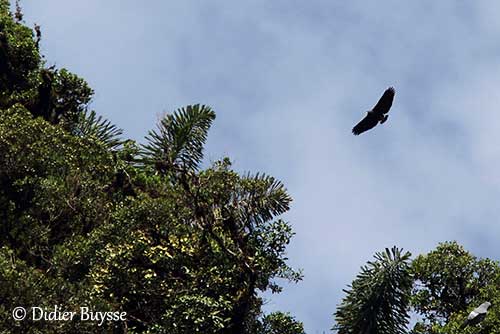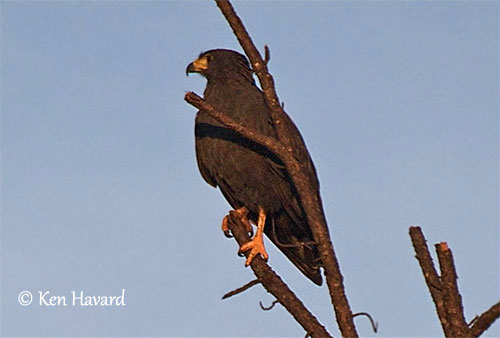
Fr: Buse solitaire
Ang: Solitary Eagle – Black Solitary Eagle - Montane Solitary Eagle
All: Einsiedleradler
Esp: Águila Solitaria
Ita: Aquila solitaria
Nd: Amerikaanse Zwarte Arend
Sd: eremitörn
Photographers:
Roger Ahlman
Pbase Galleries Peru and Ecuador
Didier Buysse
Vision d’Oiseaux
Ken Havard
My Bird Gallery & Flickr gallery 1 & Flickr gallery 2
Text by Nicole Bouglouan
Sources:
HANDBOOK OF THE BIRDS OF THE WORLD Vol 2 by Josep del Hoyo-Andrew Elliot-Jordi Sargatal - Lynx Edicions - ISBN: 8487334156
A GUIDE TO THE BIRDS OF MEXICO AND NORTHERN CENTRAL AMERICA by Steve N. G. Howell, Sophie Webb - Oxford University Press - ISBN: 0198540124
A GUIDE TO THE BIRDS OF COLOMBIA by Steven L. Hilty and William L. Brown - Princeton University Press – ISBN 069108372X
BIRDS OF PERU by Thomas S. Schulenberg, Douglas F. Stotz, Daniel F. Lane, John P. O’Neill, Theodore A. Parker III – Princeton University Press 2007– ISBN: 978-0-691-13023-1
The Cornell Lab of Ornithology - Birds of the World
Global Raptor Information Network - Working to Conserve Birds of Prey in nature
Behavioral Notes and Nesting of the Black Solitary Eagle (Buteogallus solitarius) in Belize
Observations of the Post-fledging Behavior and Prey of the Solitary Eagle
THE SOLITARY EAGLE Harpyhaliaetus solitarius A NEW THREATENED SPECIES
Wikipedia, the free encyclopaedia
Wikipedia, la enciclopedia libre
Solitary Eagle
Buteogallus solitarius
Accipitriformes Order – Accipitridae Family
INTRODUCTION:
The Solitary Eagle is found from Mexico S to extreme NW Argentina. It frequents heavily forested areas on mountain slopes and hilly areas, between 600 and 2,200 metres of elevation.
It feeds on various snake species, and also takes small vertebrates (rodents) and birds. It nests in a large cup-shaped structure placed in tree fork, up to 27 metres above the ground, but sometimes lower.
The Solitary Eagle is threatened by deforestation, shooting and human disturbance. It is currently listed as Near Threatened. It is also known as Black Solitary Eagle or Montane Solitary Eagle.
DESCRIPTION OF THE BIRD:
Biometrics:
Length: 65-75 cm
Wingspan: 157-180 cm
Weight: 3,000 gr
The Solitary Eagle is often misidentified because it is very similar to the Common Black Hawk (B. anthracinus).
The adult is uniformly dark slate-grey but it often appears black. The short, broad, squared tail shows a white median bar and a white tip. On the very broad, rounded wings, there is an indistinct grey barring on the flight-feathers.
On the head, some longer feathers may form a very short crest, rather inconspicuous.
The massive bill is black with yellow cere. The eyes are dark brown. The strong legs and the powerful feet are yellow and well adapted for catching snakes.
The female has similar plumage with brownish tinge, and she is larger than the male.

The juvenile has dark brown upperparts. Neck and head are streaked white. The back’s feathers have rufous tips. Rump and tail show some pale mottling.
The underparts are pale yellowish with black and fuscous streaks. We can see an incomplete blackish breast band. The thighs are dark brown.
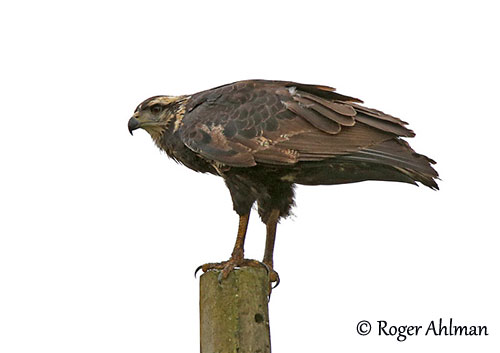
The 2d year resembles juvenile but it has grey tail with broad, dark subterminal band.
The 3d year is almost like adult but with browner wing linings. The upperparts are sparsely streaked and mottled buff. The tail band is greyer.
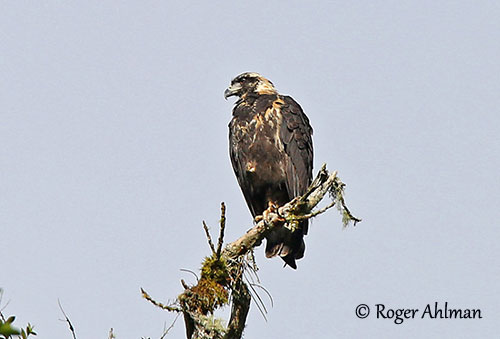
SUBSPECIES AND RANGE:
The Solitary Eagle has two subspecies.
B.s. sheffleri is found from W Mexico (from Sonora), S locally in highlands to Costa Rica and probably Panama.
This race is larger than nominate, including the wings. Head, breast and mantle are darker grey. Legs and feet are heavier.
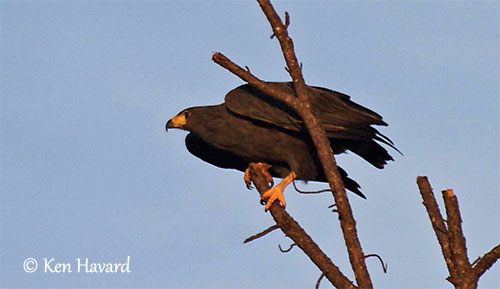
B.s. solitarius (described above) is found locally from N Colombia (Santa Marta Mts) and N and S Venezuela, WC Guyana and French Guyana, and S through humid Andes from Colombia to extreme NW Argentina (Jujuy and Salta).
HABITAT:
The Solitary Eagle is rarely seen in lowlands as it mostly frequents heavily forested areas in mountains and hills. It can be seen in dry pine forests, but also in more humid forests according to the range.
The species occurs between 600 and 2,200 metres of elevation, and is generally found in forests along the E slope of the Andes and on outlying ridges.
CALLS AND SONGS: SOUNDS BY XENO-CANTO
The Solitary Eagle gives a long, ascending whistled note when perched “keeeeeeeerloooooo”, but we can also hear series of rising piping whistles in flight “pipipipipipi…”
The juvenile produces harsher and raspier vocalizations.
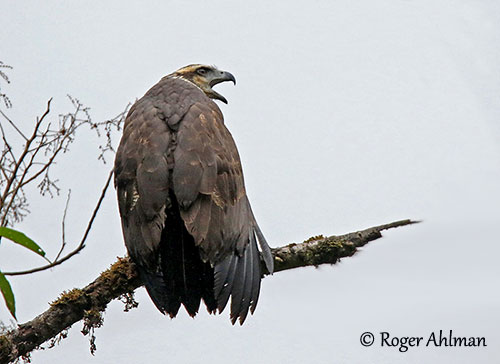
BEHAVIOUR IN THE WILD:
The Solitary Eagle feeds primarily on snakes of various species, but it also takes small mammals (rodents) and some birds. But its primary food source includes snakes and other reptiles.
This behaviour is poorly known. This species lives in dense tropical forests where it soars and hunts over large areas such as marshy woodlands, open areas and sparse tall trees.
As the name implies, this eagle is usually seen alone and sometimes in pair, soaring heavily on flat wings over hills and montane forests.
The Solitary Eagle typically builds a stick nest placed in tree fork.
The adults bring the food to the young bird at nest by moving in undulating pattern typical of thermal soaring. The male is the main food provider in the early period of the nesting cycle, while the female remains at the nest.
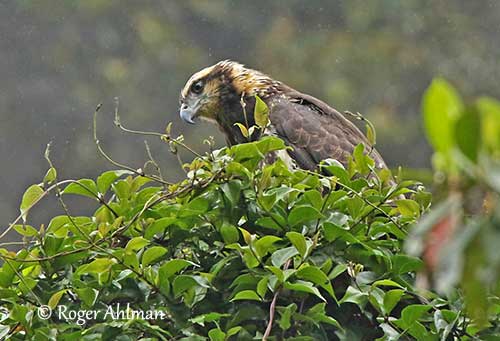
This species is probably sedentary, but it is frequently misidentified and occasional reports well away from the main Andean range require more studies.
The Solitary Eagle is a powerful raptor. It is known to soar at extreme heights and often becomes invisible to the unaided eye. It flies with alternating pattern of ascents and descents, making it difficult to follow.
This species is often considered a soaring specialist, and this type of flight is probably involved by environmental factors such as terrain, wind, temperature and heated surfaces. This flight pattern may explain the indirect route followed by the pair over mountains to the nest. Their activity increases during peak wind times.
Outside the nest, the Solitary Eagle uses flapping flight only to become airborne, to exit the forest canopy while carrying a prey, and to alight at the nest. It flaps the wings until it reaches a thermal current and then, it soars for the rest of the flight.
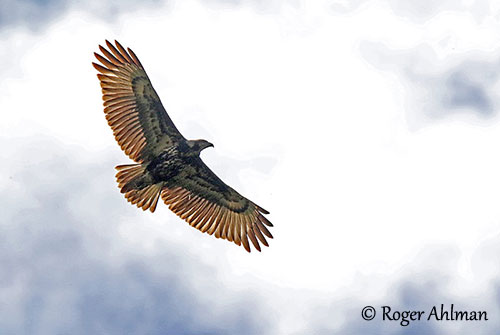
REPRODUCTION OF THIS SPECIES:
From some observations, an empty nest was found in mid-November in Peru and a second nest with a young in May/June in Mexico. Fledged young were observed in June in Colombia.
This species often breeds between pine forest and deciduous forest.
The Solitary Eagle builds a large nest with sticks, and dry and green leaves. This structure may reach 70/120 centimetres wide and 30 centimetres deep. The nest observed was placed in the fork of a pine tree, about 27 metres above the ground.
The female usually lays a single white egg. Incubation and fledging periods are currently unknown.
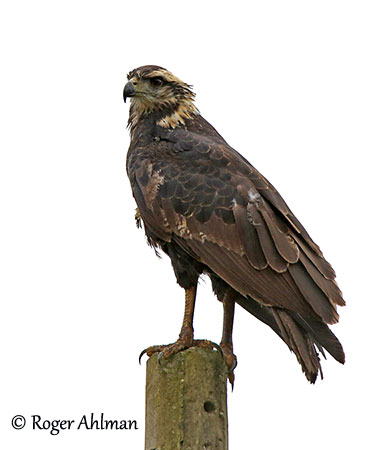
Observations in Belize between 9 July and 10 October 2009, describe some behaviour between the adults and the juvenile.
An adult was seen carrying a snake while flying low (50 metres) down into a canyon. Sometimes, two adults were flying together, landing first into a tree before flying down, probably to the nest.
A juvenile was observed some days later, perched in a tree and hopping clumsily between the branches. It was probably recently fledged. It was vocalizing and improving its flying abilities.
A food exchange on 23 August describes the adult female approaching the area while vocalizing, and carrying a large snake in her talons. The juvenile flew up to meet the female and perched beside her. Then, it took the snake and remained in the tree to eat the prey. The female flew off two minutes later.
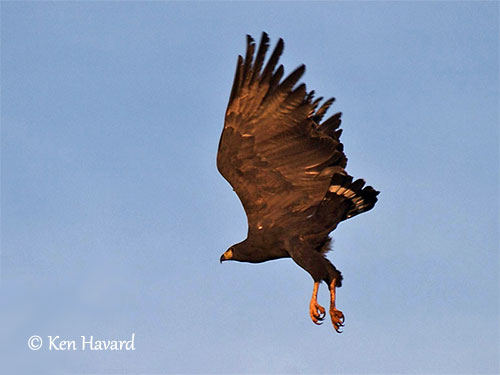
PROTECTION / THREATS / STATUS:
The Solitary Eagle is threatened by deforestation, human disturbance and shooting.
The species has always been sparsely distributed and even occurring at low densities, it has a large range.
The population is roughly estimated at 1,500/4,000 individuals, and is suspected to be decreasing due to habitat destruction and heavy hunting.
The Solitary Eagle is currently considered Near Threatened.
